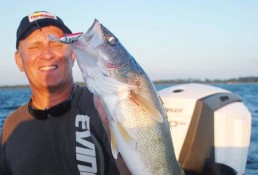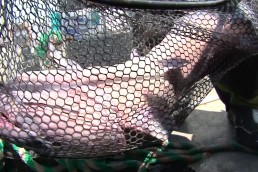Fish Don’t Always Know what They’re Supposed to Do
SHARE THIS POST
Down through the years, we’ve been taught that fish do certain things at certain times of the year, and that there are certain ways that we can catch those fish. Often, those time-tested techniques for catching fish work well, but there are times when we need to do things a little (or a lot) differently if we want fishing success. One of those situations happened to me recently.
I was fishing with Mike Frisch and Josh Zenner. Mike had been catching walleyes consistently the previous couple of days, but they had been extremely finicky. They were responding best to a 4.5 Rattlin’ Hornet crankbait that was mostly silver with some purple, and we only had one bait in that color. So we experimented with a variety of colors. We went through a lot of colors and different styles of crankbaits, but always kept that productive color in the water. Nothing produced as well until we tied on a Silver-Blue Shad 4.5 Rattlin’ Hornet. The walleyes went crazy over that color, and we had two of them, so the catching increased notably. Sometimes color really is important.
Another strange happening regarding lure preference: much of the time in the summer, fish prefer larger baits. When fish are hitting a particular size really well, if you go bigger, you’ll catch bigger fish and often more fish. That 4.5 Hornet is a pretty small bait, so when the fish started really smackin’ it, we went bigger. Interestingly, the walleyes showed a very strong preference for the smaller size. There have been many times on past summer fishing trips when we went bigger and did much better. But on this day, they wanted that smaller bait. I don’t know why, but it was obvious.
Last pretty strange thing from that trip: we were fishing a lake that was maybe 30 feet deep at the deepest and had lots of structure. Much of the time on this lake––and lakes like this––walleyes will be on structure in the summer. But the baitfish were near the top, 4 to 6 feet from the surface. And, because that’s where the baitfish were, that’s where the walleyes were. We were seeing walleye marks on the sonar just below the baitfish, less than 10 feet below the boat. We were using planer boards to avoid spooking those walleyes that were close to the surface, and the boards took most of our fish.
Are you enjoying this post?
You can be among the first to get the latest info on where to go, what to use and how to use it!
Through the years, we’ve learned a lot of things about fish and catching fish. Many of the things we’ve learned can be repeated from year to year. We know that a jig and minnow is an outstanding walleye presentation in the spring, but we’re learning that a jig and plastic is also a good producer. We know that a spinnerbait worked through the rushes can be very good for largemouth, but we’ve also figured out that a swimming jig retrieved through those same rushes will sometimes catch even more bass.
The deal is, the more we know about catching fish, the more we know there is much to learn. Fish respond in a particular way until they start responding differently. They get conditioned to colors and presentations and other factors. If we want to catch more fish, we need to continue to experiment with different lures and presentations and locations. When we start doing that, we become better anglers.
Bob Jensen is a veteran angler and fishing educator, and host of the long-running Fishing the Midwest TV show.
MWO
SHARE THIS POST
Did you enjoy this post?
You can be among the first to get the latest info on where to go, what to use and how to use it!
Bob Jensen
To see the latest episodes of “Fishing the Midwest” television, new fishing-related tips and articles from the past, visit fishingthemidwest.com. Follow them on Facebook @fishingthemidwest for fishing information and entertainment.



